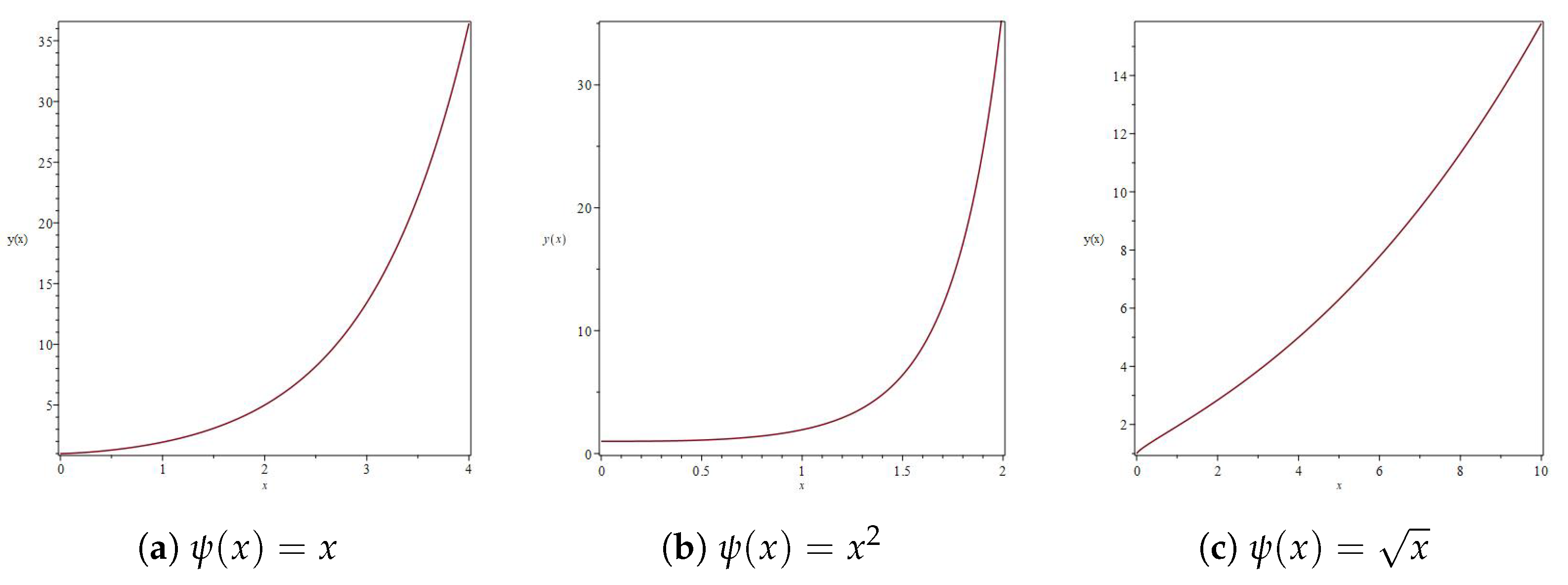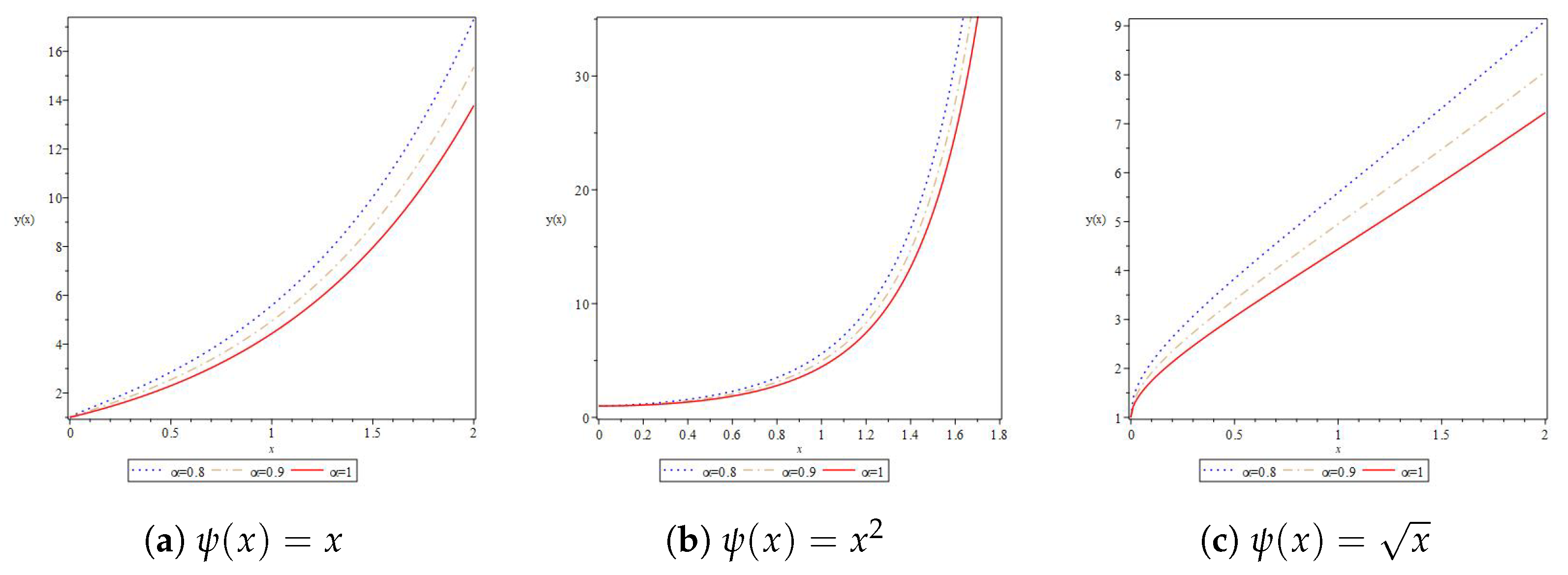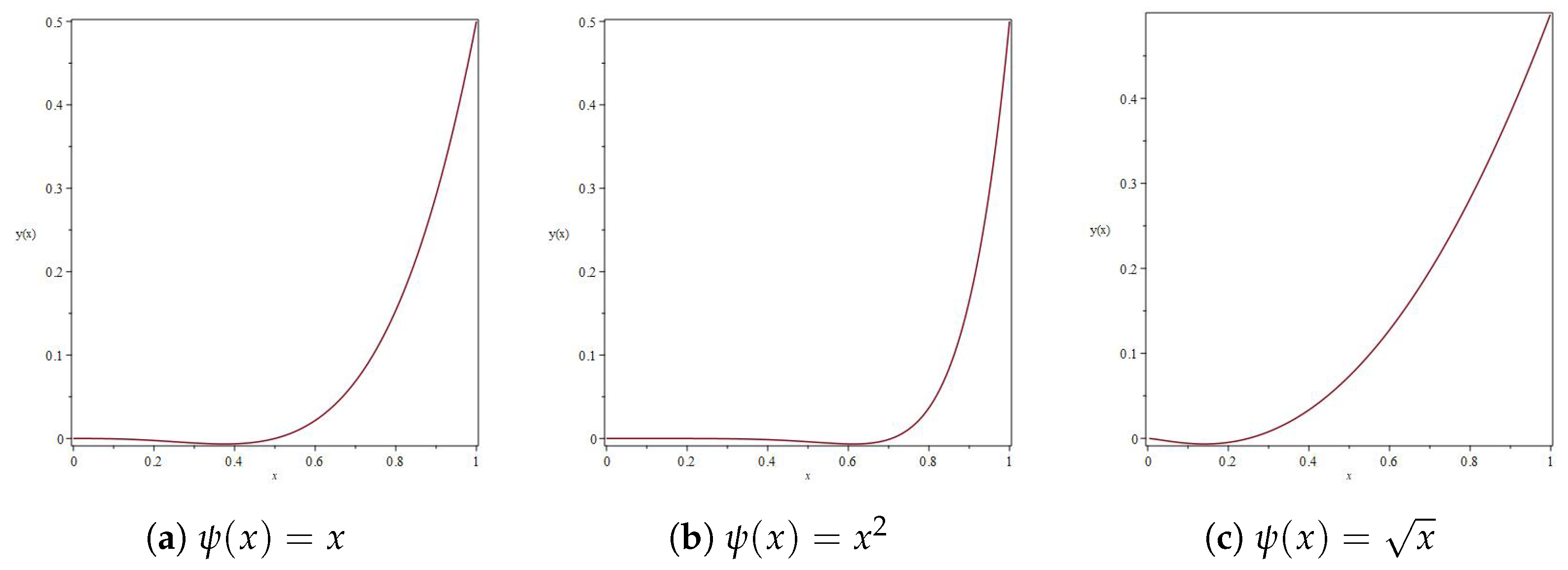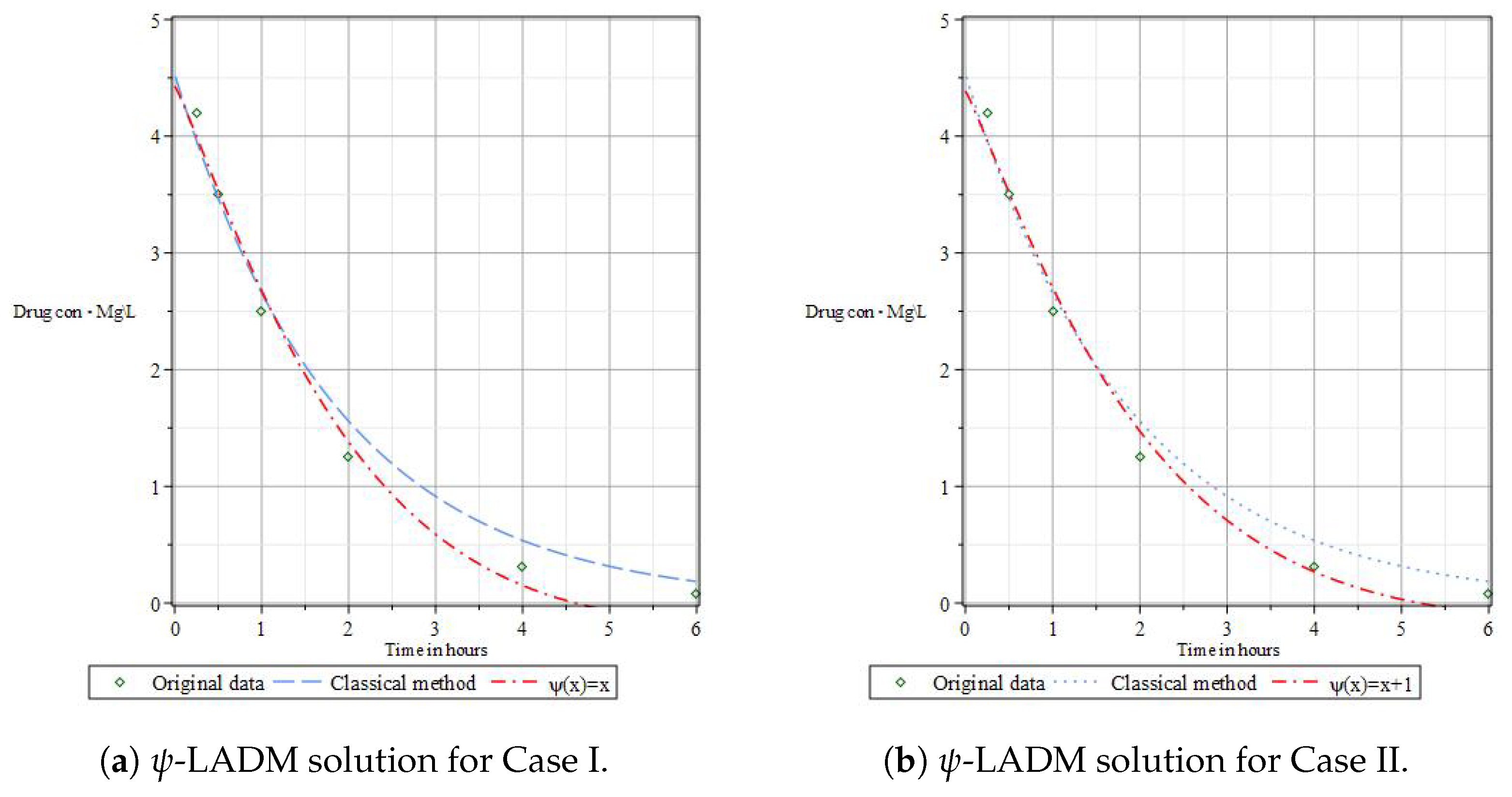Generalized Laplace Transform with Adomian Decomposition Method for Solving Fractional Differential Equations Involving ψ-Caputo Derivative
Abstract
1. Introduction
2. Preliminaries
- ;
- ;
- .Furthermore, when , this is simplified to .
3. Fundamental Description of -LADM for Solving -FDEs
4. Applications
4.1. Numerical Applications
4.2. Pharmacokinetics Application
- Case I: Consider the pharmacokinetics IVP for -FDE as followswhere , , and , with the initial dose in body beingTo solve (54) using -LADM, we apply the -LT to both sides of the model, with the help of (16), to eventually obtainNext, we apply the inverse -LT on the latter equation to obtain the followingFurther, the application of the standard ADM process yieldsthat reveals the following recurrent relationTherefore, some of the -LADM terms are recurrently expressed from the above scheme relation as followswhich, when summed up, reach the following exact solution (54) aswhere is the one-parameter Mittag-Leffler function; see Figure 6a for the graphical illustration of the obtained exact solution, in comparison to the physical dataset from [25].
- Case II: Consider the pharmacokinetics IVP for -FDE as followswhere , , and , with the initial dose in body beingTo solve (59) using -LADM, -LT is applied on both sides of the above model, with the help of (16), to eventually obtainNow, upon applying the inverse -LT on both sides of the above equation, one obtainsNext, the application of the ADM procedure givesthat leads to the acquisition of the following recursive schemeAccordingly, some -LADM terms for the governing fractional IVP are expressed from the above scheme as followsthe net sum of which yieldswhere is the one-parameter Mittag-Leffler function; see Figure 6b for the graphical illustration of the obtained exact solution, in comparison to the physical dataset from [25].
5. Conclusions
Author Contributions
Funding
Data Availability Statement
Conflicts of Interest
References
- He, J.H. Fractal calculus and its geometrical explanation. Results Phys. 2018, 10, 272–276. [Google Scholar] [CrossRef]
- Wang, Q.; Shi, X.; He, J.H.; Li, Z.B. Fractal calculus and its application to explanation of biomechanism of polar bear hairs. Fractals 2018, 26, 1850086. [Google Scholar] [CrossRef]
- Kilbas, A.A.; Srivastava, H.M.; Trujillo, J.J. Theory and Applications of Fractional Differential Equations; Elsevier: Amsterdam, The Netherlands, 2006; Volume 204. [Google Scholar]
- Teodoro, G.S.; Machado, J.T.; De Oliveira, E.C. A review of definitions of fractional derivatives and other operators. J. Comput. Phys. 2019, 388, 195–208. [Google Scholar] [CrossRef]
- Milici, C.; Draganescu, G.; Machado, J.T. Introduction to Fractional Differential Equations; Springer: Berlin/Heidelberg, Germany, 2018; Volume 25. [Google Scholar]
- Almeida, R. A Caputo fractional derivative of a function with respect to another function. Commun. Nonlinear Sci. Numer. Simul. 2017, 44, 460–481. [Google Scholar] [CrossRef]
- Almeida, R.; Malinowska, A.B.; Monteiro, M.T.T. Fractional differential equations with a Caputo derivative with respect to a kernel function and their applications. Math. Methods Appl. Sci. 2018, 41, 336–352. [Google Scholar] [CrossRef]
- Derbazi, C.; Baitichezidane, Z.; Benchohra, M. Coupled system of ψ-Caputo fractional differential equations without and with delay in generalized Banach spaces. Results Nonlinear Anal. 2022, 5, 42–61. [Google Scholar] [CrossRef]
- Boutiara, A.; Abdo, M.S.; Benbachir, M. Existence results for ψ-Caputo fractional neutral functional integro-differential equations with finite delay. Turk. J. Math. 2020, 44, 2380–2401. [Google Scholar] [CrossRef]
- Khan, H.N.A.; Zada, A.; Khan, I. Analysis of a Coupled System of ψ-Caputo Fractional Derivatives with Multipoint–Multistrip Integral Type Boundary Conditions. Qual. Theory Dyn. Syst. 2024, 23, 129. [Google Scholar] [CrossRef]
- Aydi, H.; Jleli, M.; Samet, B. On positive solutions for a fractional thermostat model with a convex-concave source term via ψ-Caputo fractional derivative. Mediterr. J. Math. 2020, 17, 16. [Google Scholar] [CrossRef]
- Alharbi, F.M.; Zidan, A.M.; Naeem, M.; Shah, R.; Nonlaopon, K. Numerical investigation of fractional-order differential equations via ψ-Haar wavelet method. J. Funct. Spaces 2021, 2021, 3084110. [Google Scholar] [CrossRef]
- Almeida, R.; Jleli, M.; Samet, B. A numerical study of fractional relaxation-oscillation equations involving ψ-Caputo fractional derivative. Rev. Real Acad. Cienc. Exactas Fís. Nat. Ser. A Mat. 2019, 113, 1873–1891. [Google Scholar] [CrossRef]
- Jarad, F.; Abdeljawad, T. Generalized fractional derivatives and Laplace transform. Discret. Contin. Dyn. Syst.-Ser. S 2020, 13, 709–722. [Google Scholar] [CrossRef]
- Fahad, H.M.; Rehman, M.U.; Fernandez, A. On Laplace transforms with respect to functions and their applications to fractional differential equations. Math. Methods Appl. Sci. 2023, 46, 8304–8323. [Google Scholar] [CrossRef]
- Alsulami, M.; Alyami, M.; Al-Mazmumy, M.; Alsulami, A. Semi-analytical investigation for the ψ-Caputo fractional relaxation-oscillation equation using the decomposition method. Eur. J. Pure Appl. Math. 2024, 17, 2311–2398. [Google Scholar]
- Alsulami, A.S.; Al-Mazmumy, M.; Alyami, M.A.; Alsulami, M. Application of Adomian decomposition method to a generalized fractional Riccati differential equation (ψ-FRDE). Adv. Differ. Equ. Control Process. 2024, 31, 531–561. [Google Scholar]
- Al-Mazmumy, M.; Alyami, M.A.; Alsulami, M.; Alsulami, A.S. Efficient modified Adomian decomposition method for solving nonlinear fractional differential equations. Int. J. Anal. Appl. 2024, 22, 76. [Google Scholar] [CrossRef]
- Dhandapani, P.B.; Leiva, V.; Martin-Barreiro, C.; Rangasamy, M. On a novel dynamics of a SIVR model using a Laplace Adomian decomposition based on a vaccination strategy. Fractal Fract. 2023, 7, 407. [Google Scholar] [CrossRef]
- Yunus, A.O.; Olayiwola, M.O.; Adedokun, K.A.; Adedeji, J.A.; Alaje, I.A. Mathematical analysis of fractional-order Caputo’s derivative of coronavirus disease model via Laplace Adomian decomposition method. Beni-Suef Univ. J. Basic Appl. Sci. 2022, 11, 144. [Google Scholar] [CrossRef]
- Alsulami, M.; Alyami, M.; Al-Mazmumy, M.; Alsulami, A. Reliable computational method for systems of fractional differential equations endowed with ψ-Caputo fractional derivative. Contemp. Math. 2024, in press. [Google Scholar]
- Awadalla, M.; Noupoue, Y.Y.Y.; Asbeh, K.A.; Ghiloufi, N. Modeling drug concentration level in blood using fractional differential equation based on ψ-Caputo derivative. J. Math. 2022, 2022, 9006361. [Google Scholar] [CrossRef]
- Almeida, R. What is the best fractional derivative to fit data? Appl. Anal. Discret. Math. 2017, 11, 358–368. [Google Scholar] [CrossRef]
- Awadalla, M.; Yameni Noupoue, Y.Y.; Asbeh, K.A. ψ-Caputo logistic population growth model. J. Math. 2021, 2021, 8634280. [Google Scholar] [CrossRef]
- Ahmed, T.A. Pharmacokinetics of Drugs Following IV Bolus, IV Infusion, and Oral Administration. Basic Pharmacokinetic Concepts and Some Clinical Applications; IntechOpen: Rijeka, Croatia, 2015; Volume 10. [Google Scholar]





| 1 | |
| for | |
| for | |
| for and | |
| for and | |
| for and |
Disclaimer/Publisher’s Note: The statements, opinions and data contained in all publications are solely those of the individual author(s) and contributor(s) and not of MDPI and/or the editor(s). MDPI and/or the editor(s) disclaim responsibility for any injury to people or property resulting from any ideas, methods, instructions or products referred to in the content. |
© 2024 by the authors. Licensee MDPI, Basel, Switzerland. This article is an open access article distributed under the terms and conditions of the Creative Commons Attribution (CC BY) license (https://creativecommons.org/licenses/by/4.0/).
Share and Cite
Alsulami, M.; Al-Mazmumy, M.; Alyami, M.A.; Alsulami, A.S. Generalized Laplace Transform with Adomian Decomposition Method for Solving Fractional Differential Equations Involving ψ-Caputo Derivative. Mathematics 2024, 12, 3499. https://doi.org/10.3390/math12223499
Alsulami M, Al-Mazmumy M, Alyami MA, Alsulami AS. Generalized Laplace Transform with Adomian Decomposition Method for Solving Fractional Differential Equations Involving ψ-Caputo Derivative. Mathematics. 2024; 12(22):3499. https://doi.org/10.3390/math12223499
Chicago/Turabian StyleAlsulami, Mona, Mariam Al-Mazmumy, Maryam Ahmed Alyami, and Asrar Saleh Alsulami. 2024. "Generalized Laplace Transform with Adomian Decomposition Method for Solving Fractional Differential Equations Involving ψ-Caputo Derivative" Mathematics 12, no. 22: 3499. https://doi.org/10.3390/math12223499
APA StyleAlsulami, M., Al-Mazmumy, M., Alyami, M. A., & Alsulami, A. S. (2024). Generalized Laplace Transform with Adomian Decomposition Method for Solving Fractional Differential Equations Involving ψ-Caputo Derivative. Mathematics, 12(22), 3499. https://doi.org/10.3390/math12223499







